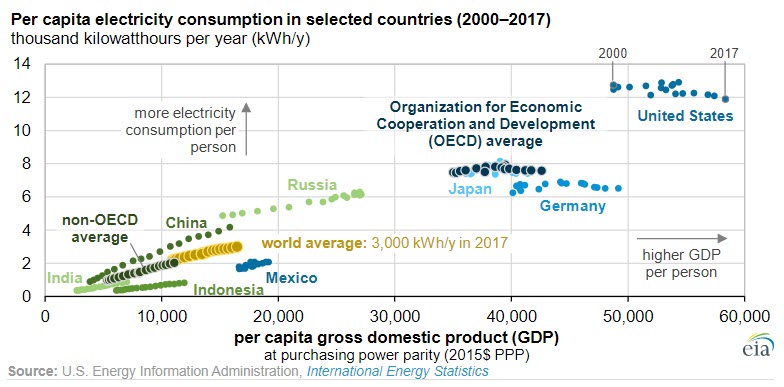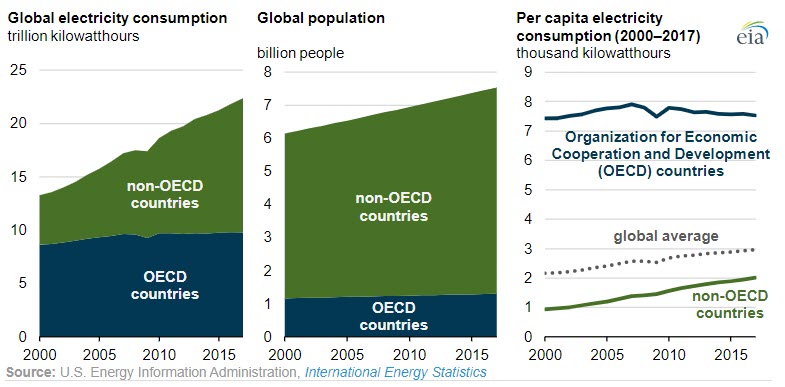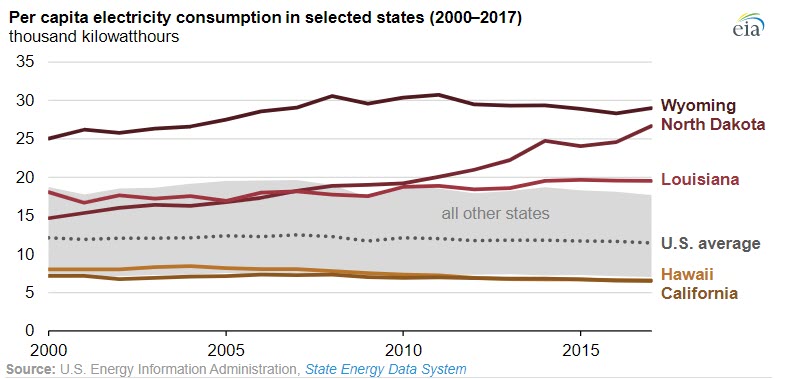Global electricity consumption continues to increase faster than world population, leading to an increase in the average amount of electricity consumed per person (per capita electricity consumption), according to the U.S. Energy Information Administration’s (EIA) International Energy Statistics. Electricity is used most commonly in buildings for lighting and appliances, in industrial processes for producing goods, and in transportation for powering rail and light-duty vehicles. Nearly all of the increase is attributable to growing electricity consumption in developing countries outside the Organization for Economic Cooperation and Development (OECD).

Increases in per capita electricity consumption reflect possible changes in the composition of the economy, such as shifts to more energy-intensive industries, and changes in service demand, such as growing demand for air conditioning and appliances.

The increase in consumption from these factors is partially offset by efficiency measures, such as more efficient lighting. Regionally, per capita electricity consumption in a number of countries has been affected by outsourcing energy-intensive industries to other countries. In the United States, total electricity consumption has risen slightly since the early 2000s, but electricity consumption per person decreased by nearly 7% between 2000 and 2017 because of improvements in energy efficiency and changes in the economy that have resulted in less electricity use per unit of economic output (as measured by gross domestic product, or GDP).
Growth in global electricity consumption is related to economic growth, but the relationship differs, depending on the country. Per person economic growth can occur independently of growth in per person electricity usage in countries with large, developed economies; largely satisfied residential electricity demand; and relatively smaller portions of economic growth coming from industrial production. Producing a service with greater economic value does not necessarily require any more electricity than a lower-value service.
In countries with rapidly growing residential electricity consumption and growing energy-intensive activities, electricity use tends to more closely correspond to growth in economic activity. Per capita electricity growth in the economies of less developed non-OECD countries has more than doubled between 2000 and 2017, compared with a nearly flat trend in the economies of more developed OECD countries.
At the national level, average per capita electricity consumption values can mask the large variation within a country. For example, the United States population averaged nearly 12,000 kilowatthours (kWh) of electricity consumption per person in 2017, but on a state basis, annual per capita electricity consumption ranged from more than 25,000 kWh in states such as Wyoming and North Dakota to less than 7,000 kWh in states such as Hawaii and California.

EIA’s International Energy Statistics database includes series for population, electricity consumption, and gross domestic product. Within the United States, EIA’s State Energy Data System contains data for state-level population and electricity sales.
"consumption" - Google News
June 15, 2020 at 09:05PM
https://ift.tt/3eh0fl2
Global electricity consumption continues to rise faster than population - EnerCom Inc.
"consumption" - Google News
https://ift.tt/2WkKCBC
https://ift.tt/2YCP29R
Bagikan Berita Ini














0 Response to "Global electricity consumption continues to rise faster than population - EnerCom Inc."
Post a Comment